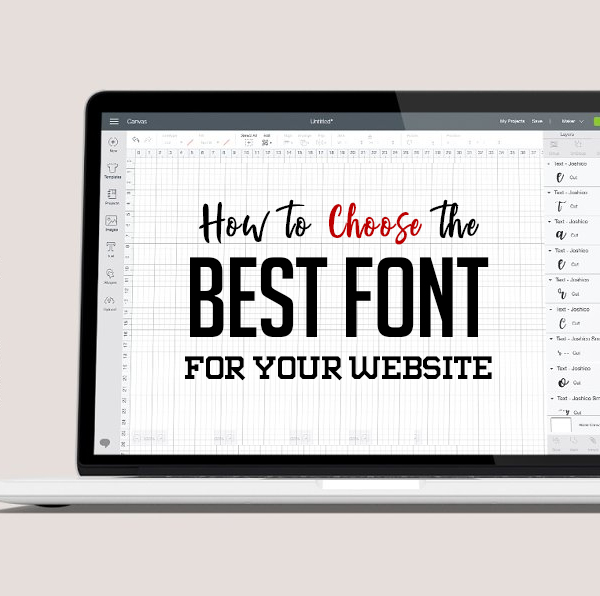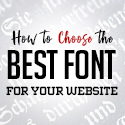Designing websites is a very intense process that entails lots of hard works. There are various things that you need to think about, such as the logo, color scheme, layout, text designs, and navigation. But the trickiest of designing a website perhaps lies in getting all the elements together to come up with one logical, well-balanced, and compact unity.
Website fonts are actually part of this unity. As a web designer you might find yourself developing a whole career around it, and even get paid really nicely.
As soon as site visitors get the overall impression of your site, they will surely focus on the texts to learn more about your brand and other essential things about you. When getting the design components together, it is highly imperative to pay close attention to the font design. There are numerous places to get quality fonts but make sure that the typeface that you choose is clean, readable, and with the right striking.
The following are ways on how to choose the best font for your website that can help you achieve a beautiful, well-designed professional website.
1. Begin with the Basics
There are many aspects that you need to look into, but it would be best to begin with, the basics before you go further. In case you opt for Sans or Serif, note that these fonts fall in the elementary classification or category. According to the Roman alphabet, Serif fonts are often characterized by decorative strokes found at the end of the horizontal and vertical strokes of letters. Georgia and Times New Roman are the most common Serif fonts.
If you wanted to try the bolder approach, you could check on fonts like Portrait collection, Freight text, or Noe Display. There are also Google’s Serif typefaces that can be used for free such as Crimson Text, Cormorant Garamond, Playfair Display, and more. The type you will choose highly rest on on your mood and your targeted audience. These are important factors to remember when dealing with ways on how to choose the best font for your website. On the other hand, Sans fonts symbolize straightforwardness, minimalism, and simplicity. Nevertheless, one of the notable features of Sans Serif fonts is that these are highly flexible.
When figuring out the look of your fonts or your typeface, three elements of design can be crucial. These elements are leading, kerning, and tracking. These aim to modify the space between letters to become visually appealing. Moreover, contrast is used to emphasize the different text chunks in many ways significantly. Different types of contrasts include weight, size, and structure.
2. Your Typographic Choice Must Reflect the Purpose of Your Design
There are lots of fonts to choose from, and your choices of the best fonts for your website are limitless. If you do not know what you exactly want, it will be difficult for you to make a choice, and this will complicate things. One good way on how to choose the best font for your website is to consider the purpose of your web design carefully and the type of audience you are targeting. From there, you need to determine if the styling of the font you prefer corresponds with the message you wish to convey with your site visitors.
Upon figuring out these main principles, there are still some important questions that you need to ask yourself when choosing the best font for your website, such as:
- What’s the nature of your website and your brand?
- Does your site revolve around a particular project? Is the project short term or long term?
- Do you aim for functionality and practicality, or do you want to go for the web-safe fonts?
- Do you want to stand out and try some unique website font choices?
Asking these questions can help you gain insights and a general idea of what you really want. If you come across a font, deciding whether this font works for you or not will become a lot easier.
3. Select the Number of Fonts and Rank them According to Importance
When choosing a number of fonts for your site, it is recommended that you aim for not more than three fonts. The primary font is the most visible font on your web page, and this must compliment your brand identity. The primary fonts are often used for larger texts like heading. Opting for fonts like Qontra, Ikaros and Voga are suggested. The secondary font is used for your body copy. Verdana, Roboto, and Futura are excellent choices. The tertiary or accent font is optional.
4. Pay Attention to the Load Times
Fonts that take too long to load completely may not be the best solutions for you. There are ways that can help you prevent fonts from slowing the speed of your website down. These include sticking to a limited number of fonts. Loading speed is actually one of the reasons why you should not go overboard with the number of fonts. You simply have to choose your needed style. Avoid downloading languages that you will not use.
5. Be Mindful on the Font Combinations
When pairing different website fonts, remember that every font has a unique character. Some website fonts appear serious, and some are more refined. Other fonts have a spontaneous and quirky feel to them. Combining two fonts with diverse moods may do the trick. You can consider combining blunt types of fonts with more subdued and neutral fonts. One combination that you should not go wrong with is mixing sans serifs and serifs.
6. Font Inspiration and Useful Tools
In case you need more assistance as you find ways on how to choose the best font for your website, you can go online as there are plenty of web sources that can offer you with font inspiration. There are also full collections of great typography choices ranging from books, tools up to use blogs to help you decide. Some of the websites worth checking for are Fonts in Use and Typewolf.
Conclusion
Even though the web is packed with gorgeous looking fonts and graphic designs, it is important to know your exact needs and the nature and purpose of your website. This is an important part of the font selection process. Remember that your choice for the best font for your website matters because this has something to do with the overall experience of your site users.

